#bird-cherry ermine moth
Text
Moth Of The Day #139
Bird-cherry Ermine
Yponomeuta evonymella
From the yponomeutidae family. They have a wingspan of 16-25 mm. They occupy all sorts of habitats. They can be found all throughout Europe.
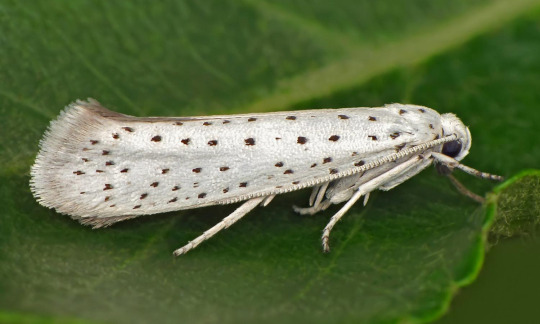

#moth#moths#lepidopterology#lepidoptera#pretty moth#nature#insect#bugs#moth of the day#motd#insects#bug#bugblr#lepidoptery#entomology#bird-cherry ermine#bird-cherry ermine moth#yponomeutidae#yponomeutidae moth
251 notes
·
View notes
Text
Currently the Ermine Moth larvae of the species Yponomeuta evonymella, also known as the "Bird-Cherry Ermine", are getting ready to metamorphose and it looks so freaking neat in my opinion!
Ermin moth larvae are not dangerous, but they often kill the trees they invade and can cause skin irritation if handled. They often hang from trees by their silk, especially in this stage, so you can run into them.
The larvae tend to build clusters at the end of a silk string, wrapping around their food, to feed together.
Bird-Cherry Ermine Moths look like dalmatians, in my opinion, they are white with black spots covering their wings and torso. Their wingspan ranges from 16mm to 25mm.
The moth can be found in the whole of Europe and the northern and eastern part of Asia.
Reference pictures:
Bird-Cherry Ermine Moth Catipillars/ Larvae

Bird-Cherry Ermine Moth Cocoons & Pupa

Bird-Cherry Ermine Moths
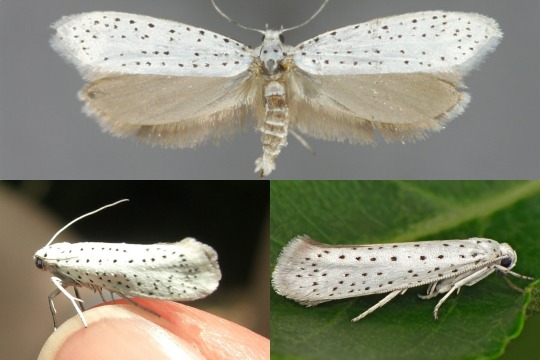
A few more references:
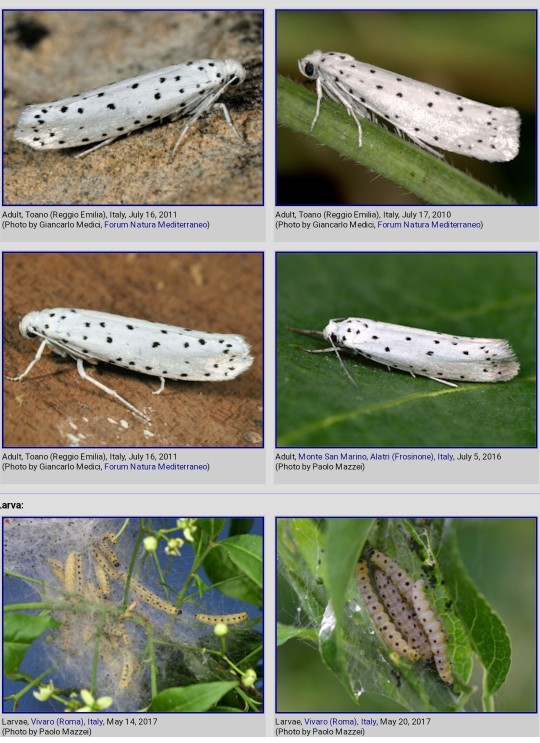
.゚.*・。゚×゚。・».゚°・✧ ↓ DNI ↓ ✧・° ゚.«・。゚×゚。・*.゚.

#nates facts#bugs#Bird-Cherry Ermine Moth#moths#sfw interaction only#sfw#tw bugs#tw: bugs#insects#nates life
9 notes
·
View notes
Text
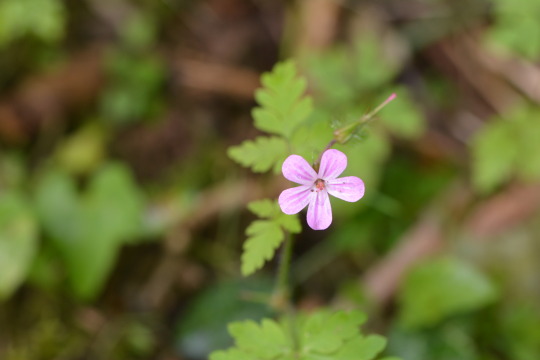


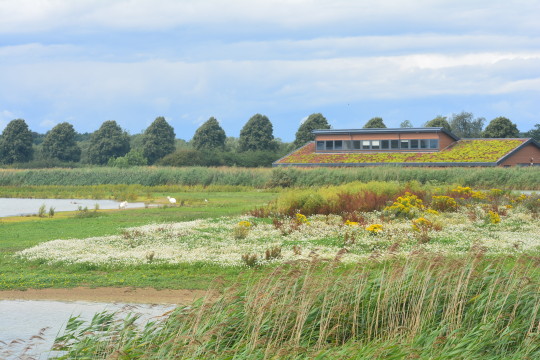
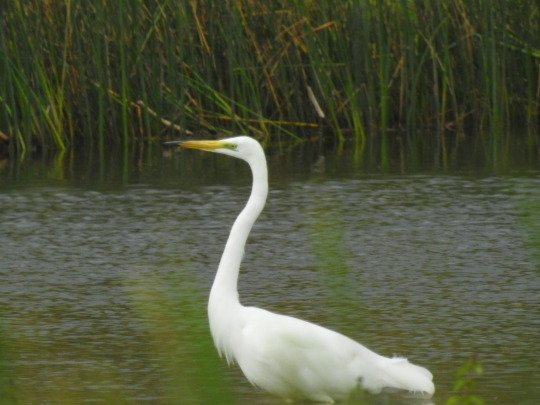

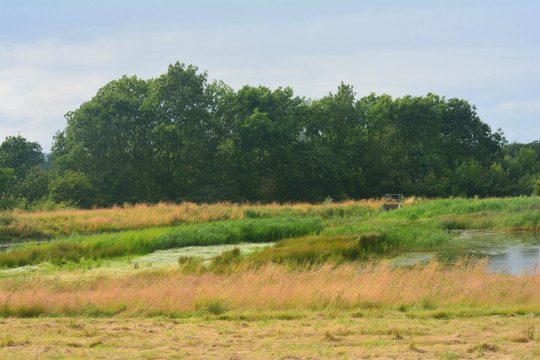



16th July 2023: Egleton, Rutland Water
Photos taken in this set: 1. Herb-Robert. 2, 3, 4, 6 and 7. Views at this beautiful reserve. 5. Great White Egret, a star bird again this weekend. I still find it quite surreal when we have a run of visiting good habitats for them and they're so commonplace, being a bird that was a real rarity when I first got into birdwatching. They're great to watch too with their larger than life stature and quirky movements. 8. Green Sandpiper, a key bird that we wanted to see at the nature reserves whilst away and it was an honour to see loads of them on lagaoon four. They are such beautiful birds and I really just enjoyed watching them and taking them in. 9. Comma, one of a few wonderful butterflies I enjoyed seeing especially in a blooming patch of meadow. 10. Egyptian Geese, another key Rutland bird, with adorable goslings. The gosling I saw of one at Petersfield Heath Pond earlier in the month was the first Egyptian gosling I'd seen I think but was bigger so it was lovely seeing these little goslings.
Another year tick in Yellow-legged Gull seen nicely with Herring and Lesser Black-backed Gulls for comparison and some chicks of the latter in an Osprey nesting platform were other key birds seen, as well as stunning views of Osprey and Hobby acrobatically working through the air seeing both successfully hunt. Birds I adore seen so well this weekend. Sand Martin, Little Egret, Great Crested and Little Grebe, Shelduck, Blackcap seen extremely well, Reed Warbler, delightful Teal, Gadwall, Lapwing, Oystercatcher, Common Sandpiper, Common Tern, Swift, Goldfinch, Pied Wagtail and Linnet chasing each other and Stock Dove were other key birds seen. It was an insect fest with Painted Lady, Red Admirals, Gatekeeper, Ringlet, Meadow Brown, Brimstone, Small Tortoiseshell seen well at the visitor centre, Small Skipper, Green-veined White, Small White and Speckled Wood butterflies, Southern Hawker, Common Darter, Brown Hawker and Black-tailed Skimmer dragonflies, Common Red Soldier beetle, ladybird, Bird-cherry Ermine moth and Marmalade and Long hoverflies other standout insects seen. Poppy, fox-and-cubs, bird vetch, wild carrot, lady's bedstraw, field scabious, self-heal, viper's-bugloss, red campion, white deadnettle, white and broad-leaved clover, thistle, great willowherb, ragwort, forget-me-not, burdock and meadowsweet were other key plants seen.
#meadowsweet#photography#birdwatching#lady's bedstraw#painted lady#yellow-legged gull#green sandpiper#white deadnettle#england#uk#world#nature#viper's-bugloss#marmalade hoverfly#long hoverfly#small skipper#bird-cherry ermine moth#happy#photos#osprey#hobby#lesser black-backed gull#2023#egleton#great white egret#egyptian goose#rutland water#rutland#europe#walking
6 notes
·
View notes
Text
Moth of the Week
Bird-Cherry Ermine
Yponomeuta evonymella

Image source
The bird-cherry ermine is a part of the family Yponomeutidae, the ermine moths. It was first described in 1758 by Carl Linnaeus. It was originally placed in the genus Phalaena but was later transferred to the genus Yponomeuta, becoming Yponomeuta evonymella. This species’ common name comes from their main food plant: Bird Cherry.
Description This moth has a white thorax, head, and forewings. The forewings have five horizontal lines of small black dots, and a few black dots are also on the back of the thorax. The hindwings are shorter and wider than the forewings and are a beige/light brown color. Both the forewings and hindwings have a fringe on the end however, the forewings’ white fringe is short and only on the outer margin while the hindwings’ brown fringe is all over the hindwings’ edges besides the parts touching the forewings. Additionally the hindwings’ fringe is longer on the bottom of the wing. This moth’s thin and wiry antennae are two thirds the length of the forewing and are usually white.
Wingspan Range: 16 - 25 mm (≈0.63 - 0.98 in)
Diet and Habitat This species’ caterpillars mainly feeds on Bird Cherry (Prunus padus), but they also occasionally feed on cherry (Prunus) or buckthorn (Rhamnus). They are known to sometimes be pests of the bird-cheery because the caterpillars pupate and feed together in web like nests that can cover whole trees. This web keeps them protected and allows them to eat mostly unbothered by other insects and predators. The tree is still likely to survive after this, but may grow less in the following growth season/spring. Adults feed on nectar.
This species can be found in Europe and the northern and eastern parts of Asia. They live in many habitats such as river lowlands, deciduous forests, alluvial forests, stream banks with bushes and trees, gardens, parks, and more. Strangely according to Butterfly Conservation, this moth can be found “often far from the known foodplant.”
Mating This moth is seen in June to September and has only gerarion per year. Females let their eggs on the winter buds of their food plants.
Population sizes fluctuate, but it’s not uncommon for mass outbreaks of caterpillars to happen, which results in defoliated trees.
Predators This species is preyed on by parasitic wasps and seems to have few other predators.
Fun Fact This moth is attracted to light. Additionally when disturbed, this moth can skip away and falls to the ground. Note: this second fact does not currently have a citation on Wikipedia so it may be disproven in the future.
(Source: Wikipedia, Butterfly Conservation)
#libraryofmoths#animals#bugs#facts#insects#moth#lepidoptera#mothoftheweek#Yponomeuta evonymella#bird-cherry ermine#Yponomeuta
108 notes
·
View notes
Text
@petalprayermantis submitted: The caterpillars are having a feast in the park trees near my home and have also spilled on the grass as well with their webbing. What might these guys become as adults?
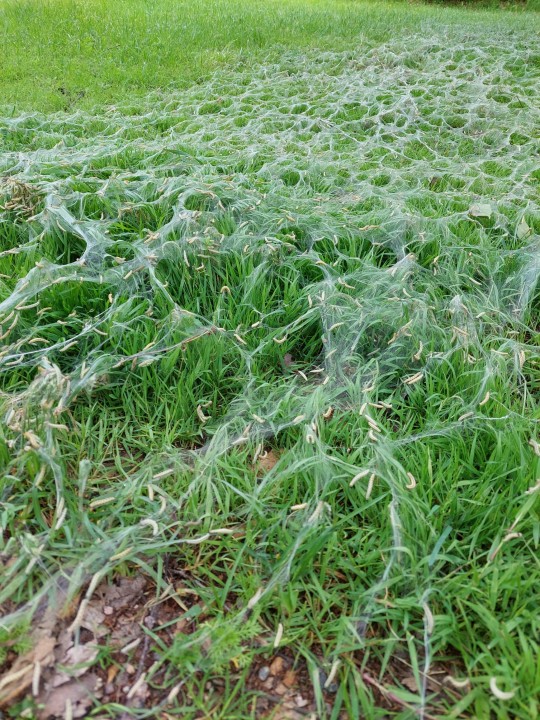
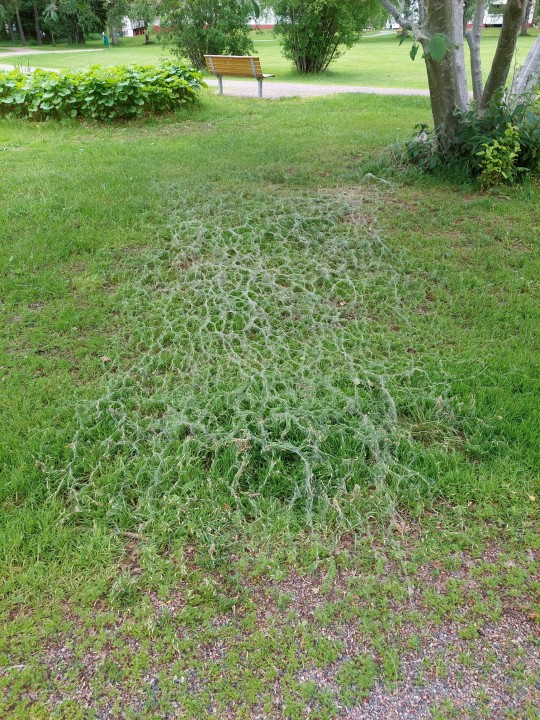
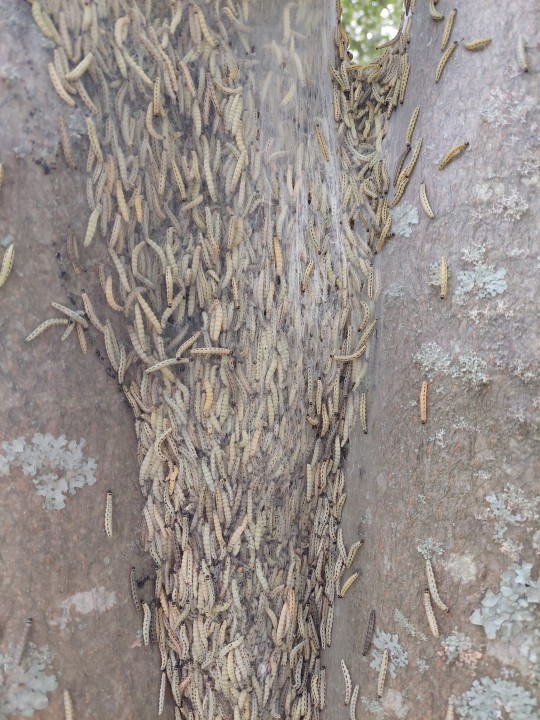


Uusimaa, Finland
Wow, that’s a whole lot of children. I love them. They’re bird-cherry ermine moth caterpillars! Adults look like this:
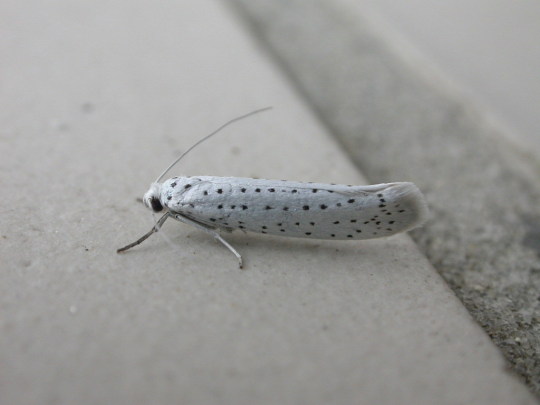
Photo by Donald Hobern
Caterpillars feed in groups and can cover an entire tree in protective webbing! They’re capable of defoliating an entire tree, but luckily, it doesn’t normally kill the tree.
220 notes
·
View notes
Text
Butterflies and moths of Doriath
Flora, fauna, geography and environment Masterlist
As always I included world building notes at the bottom so it’s not just a list of species
There are hundreds of species of butterflies found throughout the region of Doriath. Though Tolkien abandoned the idea that butterflies, all originated in the Nan Tathren, which was written in the book of lost tales, I do like to headcanon that this remained a legend or folktale in universe
Note: there are so many species of insects, this unfortunately cannot be a complete list
Primarily Neldoreth: orange tip (outskirts), elm autumn moth, Aglia tau, silver washed fritillary, dotted border moth, brown tail moth, comma butterfly
Primarily Nivrim: Checkered skipper, purple hairstreak (found in Region too), green hair streak, large copper, white prominent moth, purple emperor, large tortoiseshell
Primarily Region: Holly blue, northern blue, oak lantern moth, bird cherry ermine moth, blotched emerald moth
Throughout Doriath: ghost moth, wood white, cranberry blue, green longhorn moth, Luna moth, peacock butterfly, ghost moth, lilac leafminer moth, paper moth, white Pearl moth, red admiral, Heath fritillary, light emerald moth
Forest edges and clearings: short tailed blue, pea blue, purple edged copper, small copper, speckled wood, green hairstreak, wal brown, scarce swallowtail, clouded Apollo, blue spot hairstreak, twin spot fritillary, Julia,
World building notes
-Butterflies and moths, as a whole are associated among the Sindar with transformation and cycles of life as they are in many cultures. They are also symbols of abundance, color and precision/agility. Different species and varieties will have more specific connotations, however
-Arthórien has rare, even rainforest butterflies due to the difference in temperature and rainfall. I will make a separate post for its butterflies!
-The gardens of Menengroth also have several species of rare butterflies not found elsewhere in Doriath. These are nurtured by Melian’s power.
-ghost moths are associated with spring and summer for their bright colors and emergence in warmer weather. Insects and flora have had a large influence on color and pigmentation in Sindarin practices, both as inspiration and material.
There are even practices of safely collecting the dust and pollen that collect on the wings and legs of insects; it is immensely time consuming and precise.
-Orange tips can be found on the sigils of certain Doriath nobles. Their image is sometimes used in Doriathrim fashion, especially in jewel and hair pieces made from wood or metal. Alder bark is typically used to create the orange color
It was from these species among others that pollination was originally studied by the Sindar of Doriath.
-The purple hairstreak is associated with twilight and the darker reaches of the forest. This is primarily for its color as like most species of its family, they tend to emerge mainly on sunny days. They feed mostly on oak trees. The name for this species in Ilkorin translates to butterfly of twilight.
Their almost shadow like appearance in flight makes them a favorite for artists who make prints and illustrate naturalist work!
-Wood whites are often associated with niphredil both for their color and their habitat.
Note: I always imagine Niënor wearing a hair piece or embroidery with this species during her time in Doriath
-Luna moths are highly associated with Melian and with Lórien. They symbolize night, dream, and desire and appear as motifs in a lot of later Sindar poetry and art
29 notes
·
View notes
Text
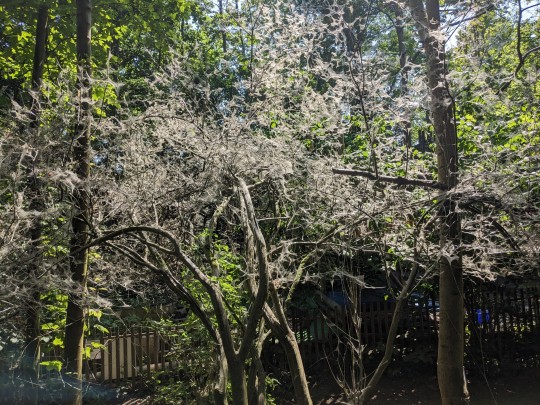
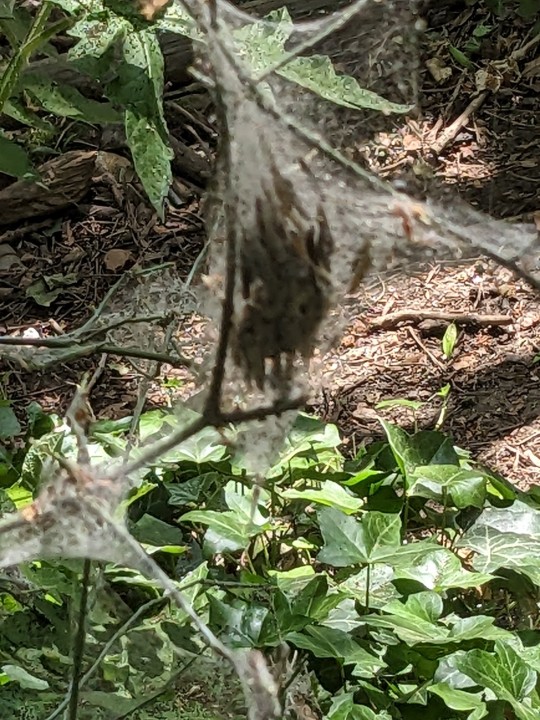
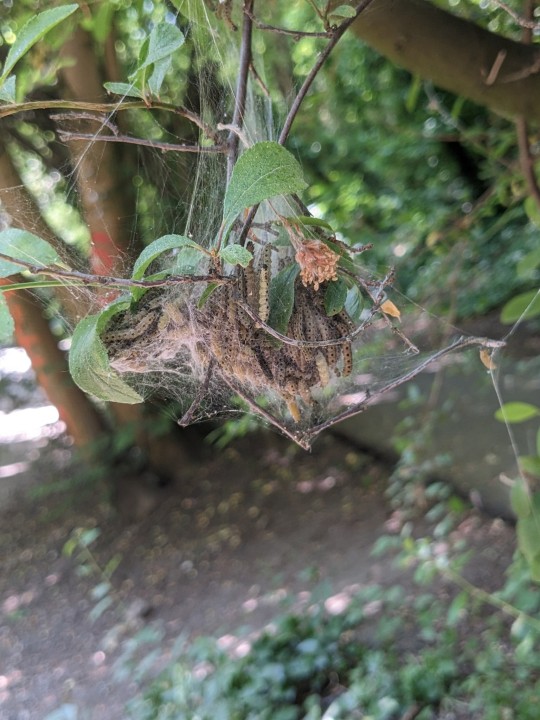
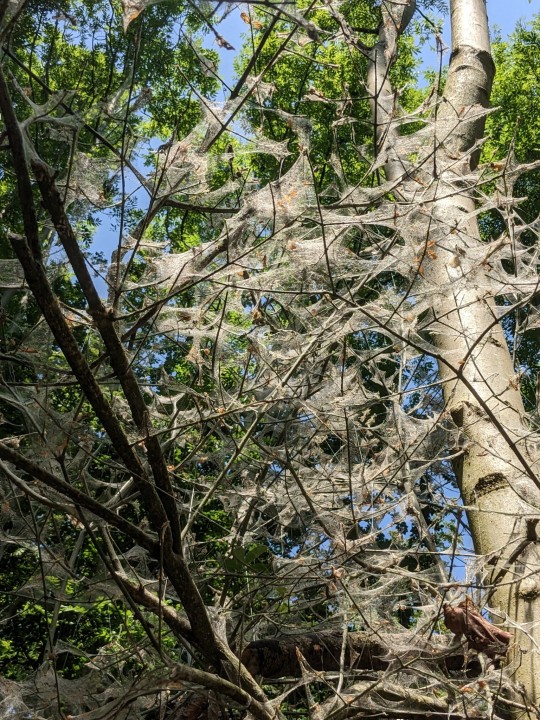
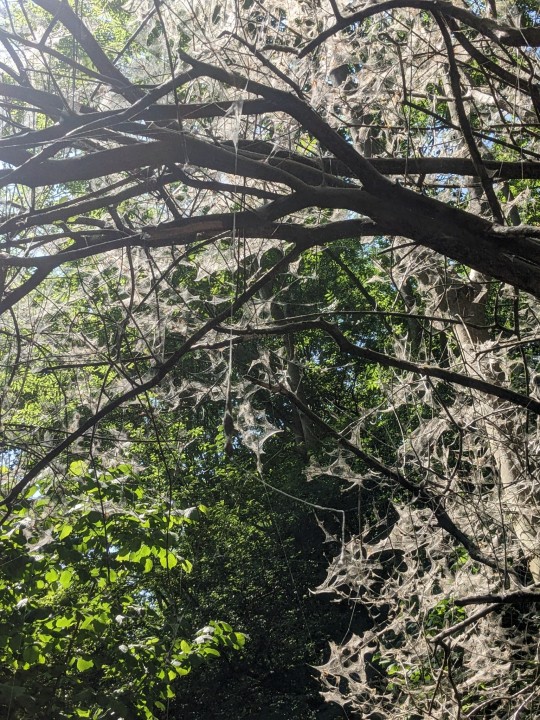
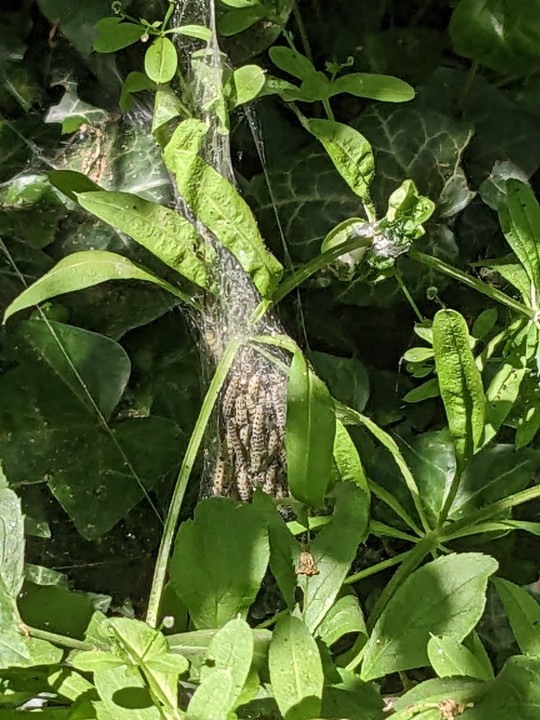
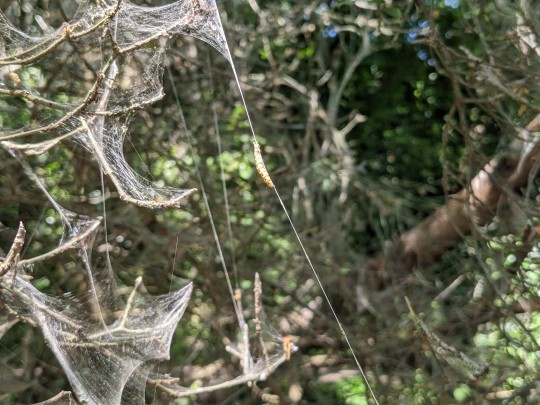
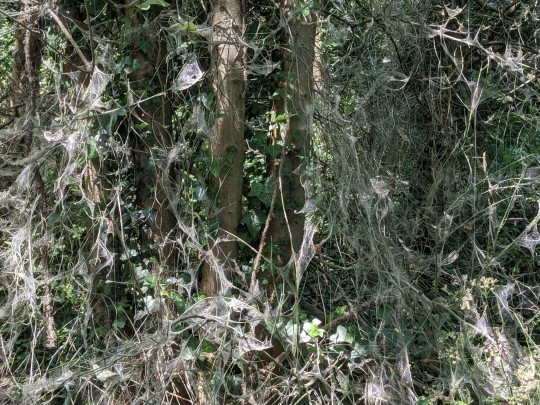
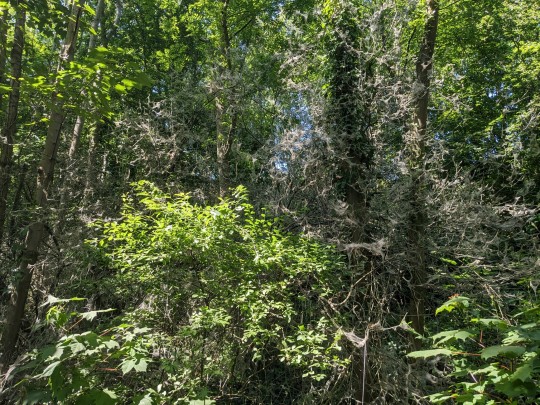

The walk near my house has recently become a place where bird cherry ermine moths have laid their eggs and now we have tons of caterpillars nearby. Bird cherry ermine moth caterpillars live in communal webs to help protect them from predators.
#cat scratches#bugs#insects#moths#caterpillars#i think it's so pretty.... it looks otherworldly and organic...
5 notes
·
View notes
Text
moth names part 1
because. list source (x)
an / ann - annulet
antler
apple
argent
ash - ashworth
arch / arche - arches
bar - barb - barber - barberry
barred
beau - beauty
belle
belt
bird
blair
blood
blot - blotch / blotche - blotchy
blox - bloxworth
blu / blue / bleu
bord - border
box
bri / bry - bright / brite - brighton
brown
brim - brimstone
brin / bryn - brind - brindle
braud - broad
bee / bea
buff - buffy
bur / burr - burn / byrn / byrne - burnet / burnett / burnette
brass
button
blush
car - carpet
cher / cherr - cheri / cherry
canary
case
chalk
chestnut
chim - chime - chimney
choco - chocolate
cin / cinn - cinna - cinnabar
cis - cist - cistus
clan - clance - clancy
clif - clifden
cloa - cloak
clou - cloud
cream
crims - crimson
cur / curr - currant
clear
clove - clover
dark
death
dec - dece - deca - deco - decem / decemb - december
dew - dewick
dingy
dot / dott
drab
drink - drinker
dusk - dusker - dusky
dag - dagger
ermine
em - emer - emera - ermeral - emerald
eye
earl - early
el / ele / elle - elephant
em - emp - emper - emperor
es / ess / esse - essex
es - est - estu - estua - estuar - estuari - estuarin / estuarine
egg - eggar
for - forest / forrest - forester
fea - feath - feather
fest - festoon
fier - fiery
fire
fish - fisher
five
flame
four
fox - foxglove
frost
goth - gothic - gothica
grey / gray
green
gal - gali - galia - galium
gar - gard / guard - garden - gardenia
ghost
goat
gold
grass
glory
hook
hawk - hawkmoth
heath
honey - honeycomb
haw - haworth
heart
horn - hornet
hum / humm - hummer - humming - hummingbird
jersey
july
knot
ken - kent - kenti - kentish
Lune - Luna - Lunar
leaf
line
lute - lutestring
loop - looper
lack - lackey
lace
lappet
lattice
lead
leo - leopard
lichen
lime
liquor - liquorice
moth - mothy / mothie - mothica
mocha
magpie
maid - maiden
manchester
map
mar - marble
march
mer - merv / merve - merveil / merveille
mint
mist - mistle - mistletoe
mot / mott
narrow
net / nett
north - northern
nov / nove - nova - novem / novemb - november
ora / aura - oran - orange
Pine
per / par - pareil
plume
plus - plusia
pug
pier - pierce - piercer
pearl
quake - quaker
rust - rustic
riv - rivu - rivul - rivulet / rivulette
red
shade
sable
skel - skele - skeleton - skeletonizer
stripe
straw
snout
silver - silverline
sweep - sweeper
swift
spot
speck
shell
swallow
tooth
tree
tail - tails
thor - thorn
tiger
treble
umber
vein
wing
white
wave
wane / wain - wainscot
wax
yellow
#moth names#types of moths#names from#names from moths#name suggestions#read dni#name ideas#name lists#name blog#read my dni#name request#name inspiration#baby names#gender neutral names#fleur speaks
11 notes
·
View notes
Note
moth enthusiast... favorite moth? :] personally biased towards tobacco & five spotted hawkmoths because i saw a lot of them growing up (the caterpillars loved our garden) but nowadays the royal walnut is my girl ^-^ hickory horned devils are also cool as hell i love seeing them irl .
ooooh good choices, good choices, royal walnuts are definitely in my top five favourite moths, i love all hawk moths so much, especially elephant hawk moths
my absolute favourite though is a tie creatonotos gangis and bird-cherry ermine. love them both for very different reasons:
creatonotos i love because. well just fucking look at the males, they fucking terrifying and beautiful

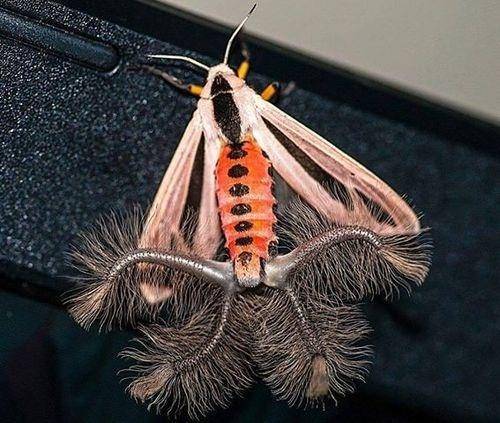
bird-cherrys i love because there are so many of them where i live and i dunno, they just bring back memories and stuff. also look at em.

very sleek looking
0 notes
Photo

Day 300
Bird Cherry Ermine Moth
#moth#moths#moth art#art#artist#moth gallery#Bird Cherry Ermine Moth#only 65 moths left this is insane
21 notes
·
View notes
Photo
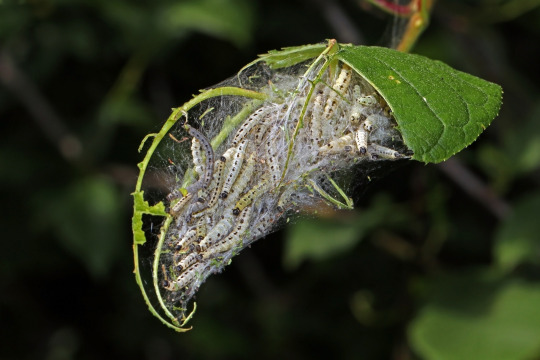
Picture of the day: Bird-cherry ermine moth (Yponomeuta evonymella) caterpillars, Lahemaa National Park, Estonia https://t.co/4SECzSWM70
#Picture of the day: Bird-cherry ermine moth (Yponomeuta evonymella) caterpillars#Lahemaa National P
0 notes
Text
my personal prefix list
A
Acanthus, Aconite, Acorn, Adder, Agate, Albatross, Alder, Algae, Alligator, Allium, Aloe, Alpine, Alyssum, Amaranth, Amaryllis, Amber, Anemone, Ant, Apple, Ash, Ashen, Asp, Aspen, Asphodel, Aster, Atlas, Auburn, Avocet, Azalea, Azure
B
Badger, Barberry, Bark, Barley, Basil, Bass, Bat, Bay, Bayberry, Beach, Bean, Bear, Beaver, Bee, Beech, Beetle, Berry, Betony, Billow, Birch, Bird, Bittern, Black, Blackberry, Blackbird, Blaze, Blazing, Bliss, Blister, Blizzard, Bloom, Blooming, Blossom, Blotch, Blotched, Blue, Bluebell, Blueberry, Bluebird, Boar, Bog, Bolt, Bone, Borage, Boulder, Bounce, Bowfin, Bracken, Bramble, Branch, Brass, Brave, Bream, Breeze, Briar, Bright, Brindle, Bristle, Broken, Bronze, Brook, Broom, Brown, Brush, Bubble, Buck, Bug, Bull, Bullfrog, Bumble, Burdock, Burn, Burnet, Burning, Burnt, Burr, Bush, Buttercup, Butterfly, Buzz, Buzzard
C
Calm, Canary, Cardinal, Carp, Cave, Cavern, Cedar, Chaffinch, Char, Charred, Chasing, Cherry, Chervil, Chestnut, Chick, Chickadee, Chicken, Chipmunk, Chirp, Chive, Chrysalis, Cicada, Cinder, Cinnamon, Clay, Clear, Cliff, Cloud, Clouded, Cloudy, Clover, Coal, Cobalt, Cobweb, Cold, Comet, Comfrey, Condor, Conifer, Copper, Cormorant, Cornflower, Corvid, Cotton, Cougar, Cove, Cow, Coyote, Crab, Crane, Crawfish, Crayfish, Cream, Creek, Creeping, Cricket, Crimson, Crocodile, Crooked, Crouch, Crow, Cuckoo, Curlew, Cygnet, Cypress
D
Daffodil, Daisy, Dancing, Dandelion, Dapple, Dappled, Dark, Dawn, Day, Dazzle, Deer, Dew, Doe, Dog, Dove, Dream, Drift, Drifting, Drizzle, Duck, Dune, Dusk, Dust, Dusty
E
Eagle, Ebony, Echo, Eddy, Eel, Egg, Egret, Eider, Elder, Elk, Elm, Ember, Ermine, Evening, Eventide, Ewe
F
Faith, Falcon, Fallen, Falling, Fallow, Fawn, Feather, Fen, Fennel, Fern, Ferret, Fidget, Field, Fin, Finch, Fire, Firefly, Fish, Flake, Flame, Flare, Flash, Flax, Flea, Fleet, Flicker, Flight, Flint, Flood, Flounder, Flower, Flurry, Flutter, Fly, Flying, Foam, Fog, Forest, Fox, Foxglove, Freckle, Freckled, Freezing, Fritillary, Frog, Frost, Frozen, Fruit
G
Gale, Gardenia, Garlic, Garter, Gator, Gentle, Ginger, Glade, Gleaming, Glimmer, Glowing, Gloom, Goat, Golden, Goldfish, Goose, Gopher, Gorge, Gorse, Gosling, Grass, Gravel, Green, Grey, Grouse, Grove, Gull, Guppy, Gust
H
Hackberry, Haddock, Hail, Half, Hare, Harrier, Haven, Hawk, Hawthorn, Hay, Haze, Hazel, Heath, Heather, Heavy, Hedge, Hemlock, Hen, Heron, Herring, Hickory, Hidden, Hill, Hive, Hollow, Holly, Honey, Hop, Hope, Horizon, Hornet, Hound, Hush, Hyacinth, Hyssop
I
Ibis, Ice, Icy, Indigo, Iris, Ivory, Ivy
J
Jackdaw, Jagged, Jaguar, Jasmine, Jay, Jump, Jumping, Juniper
K
Kelp, Kestrel, Kindle, Kink, Kite, Knotweed, Koi
L
Lake, Lamb, Larch, Lark, Larkspur, Laurel, Lavender, Leaf, Leaping, Leech, Leek, Lemming, Leopard, Lichen, Light, Lightning, Lily, Lion, Linden, Little, Lizard, Lobelia, Locust, Long, Loon, Lost, Lotus, Loud, Lupine, Lynx
M
Mackerel, Magnolia, Magpie, Mallard, Mallow, Mantis, Maple, Marble, Marbled, Marigold, Marmot, Marrow, Marsh, Marten, Mayflower, Meadow, Mellow, Merlin, Midge, Milkweed, Mink, Minnow, Mint, Mire, Mist, Mistle, Misty, Mole, Monarch, Moon, Moor, Moorhen, Moose, Morning, Mosquito, Moss, Mossy, Moth, Mottle, Mottled, Mountain, Mouse, Mud, Muddy, Mulberry, Mumble, Murky, Mushroom, Myrtle
N
Needle, Nettle, Newt, Night, Nut, Nuthatch
O
Oak, Oat, Ocean, Oleander, Olive, Orchid, Oriole, Osprey, Otter, Owl, Oyster
P
Pale, Pansy, Panther, Parsley, Parsnip, Partridge, Passerine, Patch, Pea, Peach, Pear, Pearl, Pebble, Peeper, Pelican, Peony, Pepper, Perch, Peregrine, Periwinkle, Petal, Petrel, Petunia, Pheasant, Pickerel, Pigeon, Pike, Pine, Pink, Pipit, Pitch, Plover, Plum, Poison, Pollen, Pond, Pool, Poplar, Poppy, Possom, Posy, Pounce, Prickle, Primrose, Puddle, Puffin, Pumpkin, Purple
Q
Quail, Quick, Quiet
R
Rabbit, Raccoon, Ragged, Ragweed, Rain, Raining, Ram, Raspberry, Rat, Raven, Red, Reed, Ribbon, Ridge, Ripple, Rising, River, Robin, Rock, Rocky, Rook, Rooster, Root, Rose, Rosemary, Rowan, Rubble, Rue, Rumble, Running, Rush, Rushing, Russet, Rust, Rusty, Rye
S
Sable, Sage, Salamander, Salmon, Salvia, Sand, Sandwort, Sandy, Sap, Scarlet, Scorch, Scorched, Scorching, Scratch, Screech, Sea, Seal, Sedge, Seed, Senna, Serval, Shade, Shadow, Shale, Sharp, Shatter, Sheep, Shell, Shimmer, Shining, Shiver, Shore, Shrew, Shrike, Shrub, Shy, Silent, Silk, Silver, Singe, Singing, Skip, Skunk, Sky, Slate, Sleek, Sleeping, Sleepy, Sleet, Slight, Slip, Sloe, Slug, Sly, Small, Smoke, Smudge, Snag, Snail, Snake, Snap, Sneeze, Snow, Snowy, Soaring, Soft, Song, Soot, Sorrel, Spark, Sparrow, Speckle, Speckled, Spider, Splash, Splinter, Splotch, Spot, Spotted, Spring, Spruce, Squirrel, Stag, Starling, Stem, Stoat, Stone, Stork, Storm, Stormy, Strawberry, Stream, Strike, Striped, Sugar, Sun, Sunflower, Sunny, Swallow, Swamp, Swan, Sweet, Swift, Swirl, Sycamore
T
Tabby, Tall, Talon, Tanager, Tangle, Tansy, Tawny, Teasel, Tempest, Tern, Thicket, Thistle, Thorn, Thrush, Thunder, Thyme, Tide, Tiger, Timber, Tiny, Toad, Topple, Torrent, Tortoise, Tree, Trout, Tulip, Tumble, Turkey, Turtle, Twig, Twilight, Twist, Twisted, Twitch
U
Umber, Ursinia
V
Valley, Velvet, Venom, Vervain, Vetch, Vine, Violet, Viper, Vixen, Vole, Vulture
W
Walnut, Wandering, Warble, Warbler, Wasp, Weasel, Web, Weed, Wet, Whirl, Whisker, Whisper, Whispering, Whistle, White, Whorl, Wild, Willow, Wind, Windy, Wish, Wisp, Wolf, Wood, Wool, Wooly, Worm, Wren
Y
Yarrow, Yellow, Yew
42 notes
·
View notes
Text

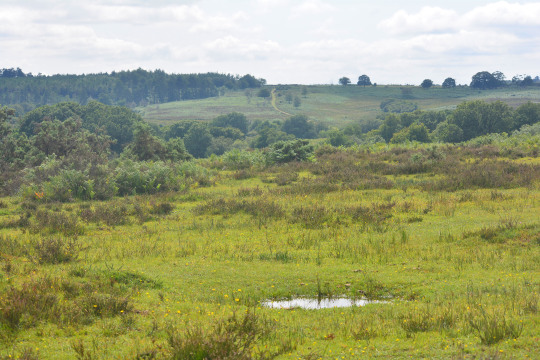
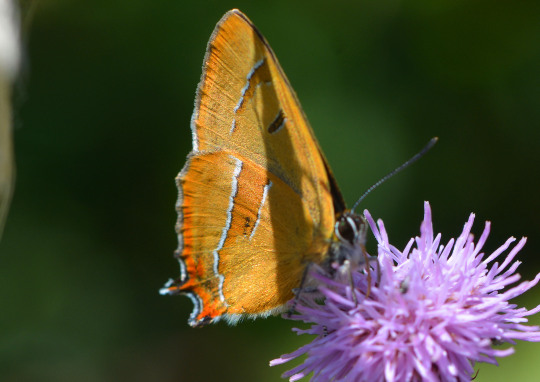

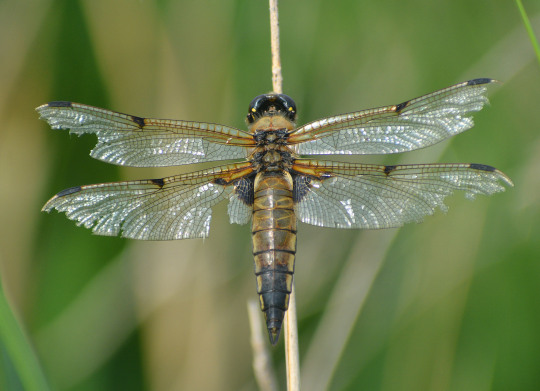

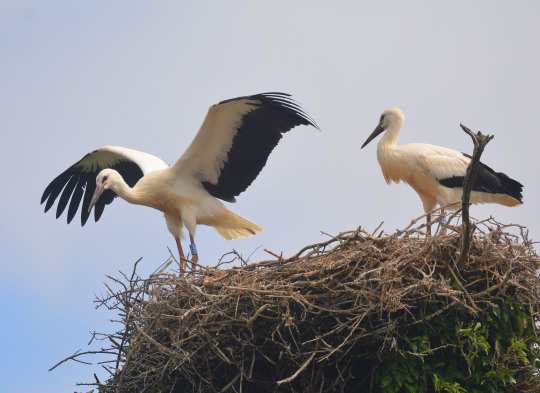
Seven of my favourite photos I took in July 2023 and month summary
The photos are of; Marmalade hoverfly at Egleton Nature Reserve at Rutland Water, view at Andrews Mare in the New Forest, Brown Hairstreak at Shipton Bellinger, Chalkhill Blue at Stockbridge Down, Four-spotted Chaser at Hickling Broad, water mint at Lakeside Country Park and White Storks at Knepp.
July was another fantastic wild month for me with so much seen and so many places visited, a key part of real core weeks in my wildlife year. We saw and did so much it feels as though things right at the start were more than a month ago!
It was one of my greatest ever months of butterflies. There were nine excellent species additions to my year; the dream moment when we were amazed to see a Swallowtail in Norfolk, another very successful Purple Emperor search at Knepp seeing them so well as well as Silver-washed Fritillary, White Admiral and lovely White-letter Hairstreak, always a quintessential summer moment I think seeing beautiful Chalkhill Blues at Stockbridge Down and Brown Hairstreak, Wall Brown and Silver-spotted Skipper on an extraordinary day at Shipton Bellinger and Perham Down making my butterfly year list my highest ever. Purple Hairstreak at Knepp and various times at Lakeside was another key butterfly I loved seeing this month, with Marbled White, Ringlet and Small Skipper enjoyed too. The arrival of Big Butterfly Count was something I enjoyed doing, counting the butterflies to help inform how species are doing again. This also helped uncover (although I’d have surely noticed anyway) for me that we are onto a bumper year of Red Admirals with so many around which has been fun. Gatekeeper, Meadow Brown, Small White, Green-veined White, Holly Blue, Common Blue, Comma, Peacock, Brimstone, Small Copper and Small Tortoiseshell were other of the target species enjoyed, with Brown Argus seen nicely this month too. Six-spot Burnet which I’ve also seen so many of this year and Silver Y are day flying moths in the count I’ve liked seeing this month in another good one for moths with my first ever Forester a pretty one and a Mint moth at Stockbridge Down as well as Synaphe punctalis on that pivotal insect day for me as well as Yellow Shell at Knepp, a few Bird-cherry Ermine at Rutland Water and Shipton Bellinger, Pearl Veneer at Lakeside and Pyrausta nigrata at Shipton Bellinger key ones seen.
Bird wise it was another smashing month, with a charming Ruddy Shelduck seen at Petersfield Heath Pond, an inspiring day at Knepp getting exquisite views of the monumental White Storks young and old, of course another valuable chance to see the astonishing and wondrous Bee-eaters at Trimingham on the Norfolk trip and in among all the inspiring talks and lovely interaction at the Bird Fair my first Green Sandpiper and Yellow-legged Gulls of the year at Rutland Water’s Egleton reserve during that long weekend both top birds of my year. On those two weekends away this month part of one of my best runs of weekends throughout the year with so much packed in and many big trips we like to do going to Norfolk and Rutland stunning views of majestic Marsh Harrier, exceptional views of Osprey including seeing one hunt, Hobby seen extremely well and at both gorgeous Great White Egrets so well established in those areas now were other big highlights, with Egyptian Geese enjoyed at both and the Petersfield Heath Pond visit including seeing young. Sand Martin, Common Tern, Blackcap, Linnet and Yellowhammer were other standouts this month, with the Lakeside Great Crested Grebes with both families doing well I really enjoyed seeing multiple times as well as Moorhens with young, seeing Peregrines in Winchester including the chick Rosie too. I have also really appreciated Swift and House Martin this month especially on patch, and with gull numbers going up again at Lakeside young Black-headed and also an adult Mediterranean Gull were key moments there this month.
It was also one of my best ever months for dazzling dragonflies and damselflies, with our first ever Norfolk Hawkers, Brown Hawker, Ruddy Darter and Emerald Damselfly coming into our year on the Norfolk trip, Brown Hawker enjoyed again alongside immense Southern Hawker views at Rutland Water with Common Darter, Four-spotted Chaser and locally and further afield Black-tailed Skimmer seen well this month. It was a top month of mammals with smashing views of Water Vole and Stoat at Rutland Water and Stockbridge Down on the long weekend, big mammals in what has got to be my best year of mammals with so many amazing species seen. Fallow and Muntjac Deers at Knepp and Norfolk respectively added to those brilliant times. There were lots of great moments with other insects with Black Clock beetle, Peacock butterfly caterpillar and Garden Tiger moth caterpillar at Hickling Broad, Marmalade (also seen at Lakeside) and Long Hoverfly at Egleton, Rutland Water in a strong month of hoverflies, striking and symbolic of summer Cinnabar moth caterpillars first seeing these at Knepp, so many Common Red Soldier beetles seen what a stalwart of summer, Black-and-yellow longhorn beetle something I was fixated on at Lakeside and Meadow grasshopper at Stockbridge Down with Common Field Grasshopper at Lakeside standing out with nice spider moments too.
In my plant year July felt like the very mature time in the flower year it is with some of the last flowers I expect to see blooming including hemp agrimony, water mint and red bartsia. Wild carrot, marjoram and basil, great willowherb, purple loosestrife, bird vetch, pyramidal orchid, St. John’s-wort, centaury, restharrow, scabious, mallow, scarlet pimpernel, many white clovers, rosebay willowherb, lady’s bedstraw, cuckoo-pint and agrimony have been others that stood out this month. With wetland, coast, meadow, rich grassland, lakes and woodland explored I enjoyed many breathtaking and panoramic views this month, as the weather was interestingly changeable. Have a good August all.
#photography#nature#rutland#norfolk#hampshire#wiltshire#sussex#uk#july#2023#birdwatching#butterflies#dragonflies#mammals#water vole#wildlife#chalkhill blue#brown hairstreak#white stork#four-spotted chaser#marmalade hoverfly#new forest#andrews mare#water mint#lakeside country park#happy#outdoors#walking#reflections#summer
9 notes
·
View notes
Photo

ECHO I
Ermine Moths, Soil, Acrylic Glass, Bird Cherry, LED
2 x 1 x 1 m
at
Voodoo55 Artspace
Berlin
2018
#installation#art#artwork#artists on tumblr#nature#plant#animal#photography#earth#planet#climate change#Anthropocene#Berlin#echo
14 notes
·
View notes
Text
@petalprayermantis submitted: Update on the ermine moths I submitted earlier! They have been hatching in great numbers, also there was some parasitic wasps I assume were there looking for unhatched ones to lay their eggs into. The one pic where it looks like the wasp has no butt she was poking into the cocoons. If you can id the wasps that would be great! Pictured in Uusimaa, Finland.

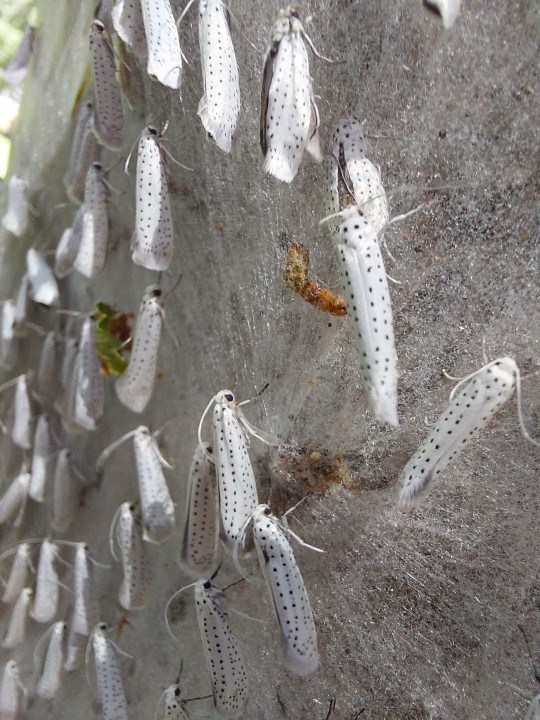
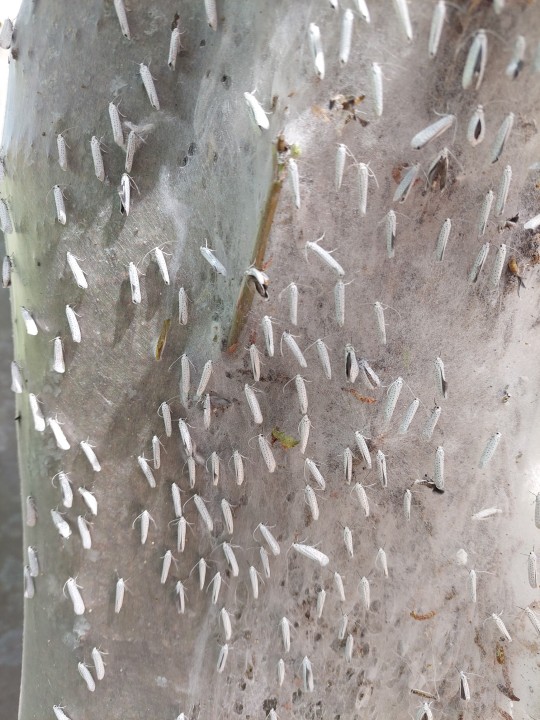

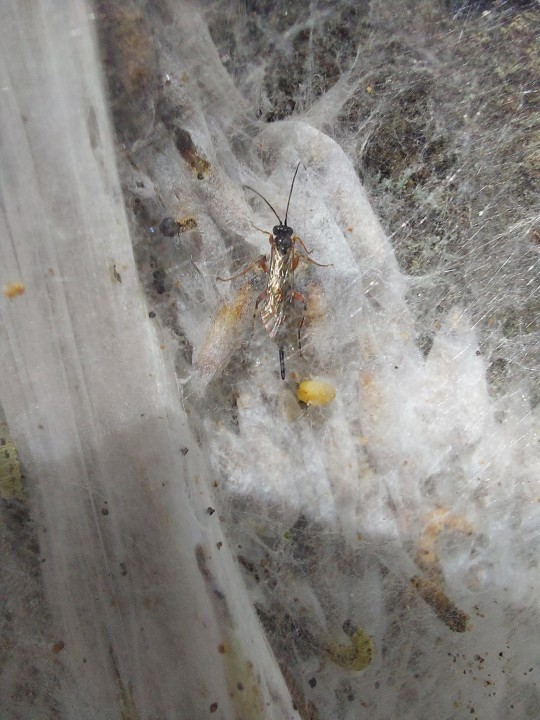

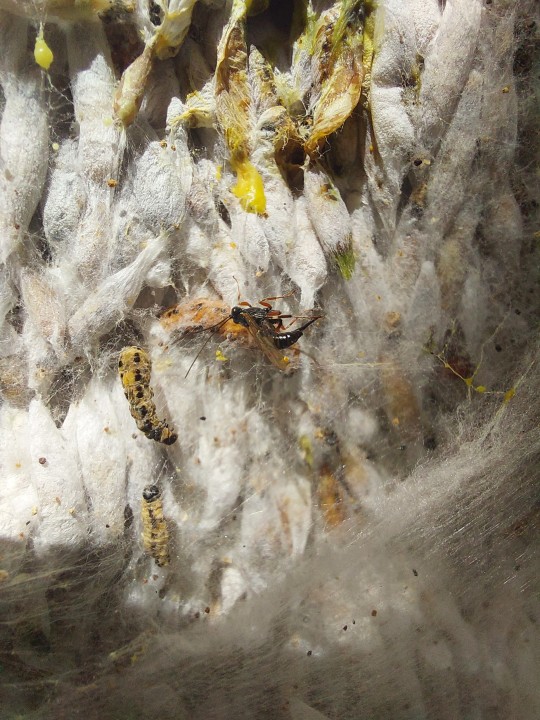
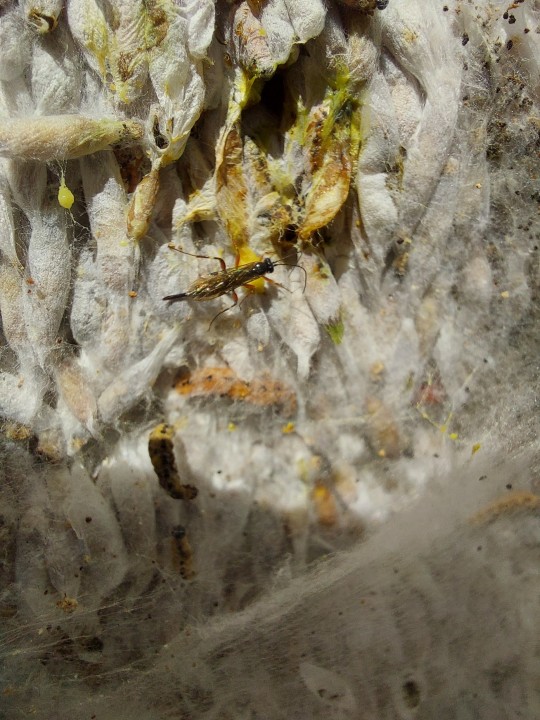
Holy moly, that’s a lot of pals! They really coated that tree in their silk. Impressive. Clearly it’s more than okay that a cute little wasp parasitizes some of these dudes as population control. The wasp looks like an ichneumonid in the genus Pimpla.
#animals#insects#bugs#submission#moth#ermine moth#bird cherry ermine moth#wasp#ichneumonid wasp#Pimpla#parasitoid#pupa#cocoon#congregation#bug death#mentioned
170 notes
·
View notes
Text
The biggest cobweb in the world?
The biggest cobweb in the world?
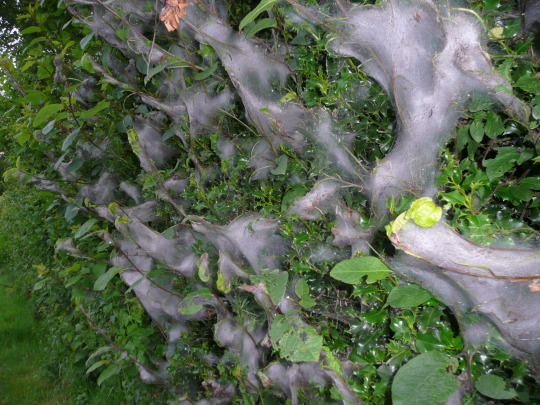
Several years ago a couple of sections of hedge near here appeared to have been wrapped in the biggest cobweb I had ever seen. The sections were about 3-4 meters long — the length of a gate. At first I thought it was something to do with planning permission — as when farmers or developers wrap a section of hedge in green plastic netting to stop birds from nesting while they wait for permission to…
View On WordPress
0 notes